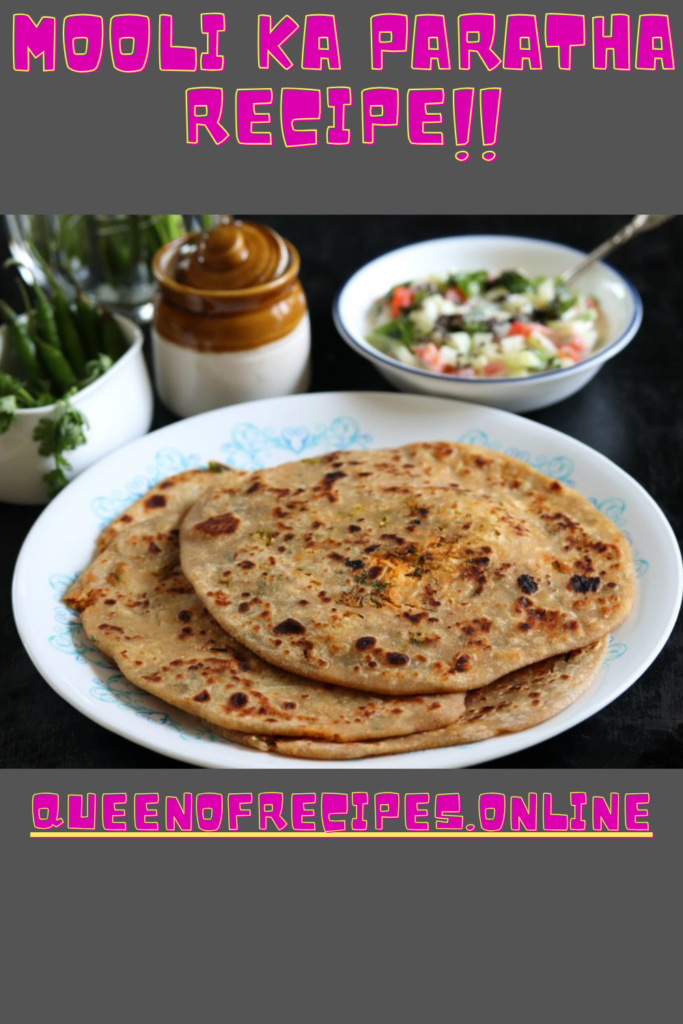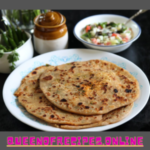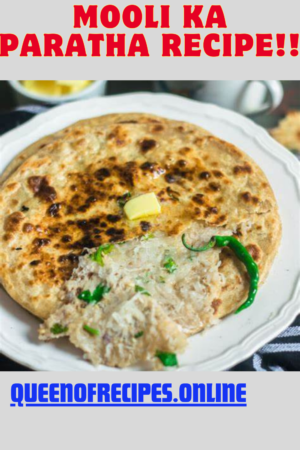Table of Contents
About Mooli Ka Paratha.
subcontinent and is particularly cherished in North India. The star ingredient, “mooli,” refers to white radish, which is grated and incorporated into the paratha’s dough along with a blend of aromatic spices. The result is a flavorful, slightly spicy, and satisfying flatbread that is often served with yogurt, pickles, or chutney. Mooli Ka Paratha is not only a tasty treat but also a creative way to enjoy the goodness of fresh radishes in a warm and comforting package.
Making Mooli Ka Paratha (Radish Stuffed Paratha) at home is a straightforward process. Here’s a step-by-step guide on how to prepare this delicious Indian flatbread:
Ingredients for making Mooli Ka Paratha:
For the Paratha Dough:
- 2 cups whole wheat flour (atta)
- Water (as needed)
- Salt to taste
For the Radish Filling:
- 2-3 medium-sized radishes
- 1/2 teaspoon salt
- 1/2 teaspoon red chili powder (adjust to taste)
- 1/2 teaspoon garam masala
- 1/2 teaspoon cumin seeds
- 1-2 green chilies, finely chopped (optional)
- 2 tablespoons finely chopped cilantro
- 1 tablespoon oil (for sautéing)
Instructions for making Mooli Ka Paratha:
Preparing the Radish Filling:
- Wash and peel the radishes. Grate them using a fine grater. Squeeze out excess water from the grated radish using your hands.
- Heat 1 tablespoon of oil in a pan. Add cumin seeds and let them splutter.
- Add the grated radish to the pan and sauté on medium heat for about 5-7 minutes, or until the radish becomes tender and the moisture evaporates.
- Add salt, red chili powder, garam masala, green chilies (if using), and cilantro. Mix well and sauté for another 2-3 minutes. Remove from heat and let the filling cool.
Making the Paratha Dough:
- In a mixing bowl, combine the whole wheat flour and a pinch of salt. Gradually add water and knead the dough until it’s smooth and pliable. Cover the dough with a damp cloth and let it rest for about 15-20 minutes.
Assembling and Cooking the Parathas:
- Divide the dough into equal-sized portions and roll them into balls, slightly smaller than a golf ball.
- Take one dough ball and roll it into a small circle (about 4 inches in diameter) on a floured surface.
- Place a portion of the radish filling in the center of the circle, then gather the edges of the dough to enclose the filling, pinching them together to seal the paratha.
- Carefully roll out the filled dough ball into a flat circle, approximately 7-8 inches in diameter. Ensure the filling is evenly distributed.
- Heat a griddle or flat pan over medium-high heat. Place the rolled paratha on the hot griddle and cook for about 2 minutes or until the bottom begins to brown.
- Flip the paratha and drizzle a little oil or ghee on the cooked side. Press down with a spatula to help it cook evenly.
- Flip again and apply oil or ghee on the other side. Cook until both sides are golden brown and crispy.
- Repeat the process for the remaining dough balls and filling.
Serve the Mooli Ka Paratha hot with yogurt, pickle, or chutney.
Enjoy your homemade Radish Stuffed Parathas!
Gluten-free Mooli Ka Paratha
Yes, you can make Mooli Ka Paratha gluten-free by using gluten-free flours in place of traditional whole wheat flour. Here’s how to make gluten-free Mooli Ka Paratha:
Ingredients for making Mooli Ka Paratha:
For the Paratha Dough:
- 2 cups gluten-free flour mix (a combination of flours like rice flour, chickpea flour, and tapioca flour)
- Water (as needed)
- Salt to taste
For the Radish Filling:
- 2-3 medium-sized radishes
- 1/2 teaspoon salt
- 1/2 teaspoon red chili powder (adjust to taste)
- 1/2 teaspoon garam masala
- 1/2 teaspoon cumin seeds
- 1-2 green chilies, finely chopped (optional)
- 2 tablespoons finely chopped cilantro
- 1 tablespoon oil (for sautéing)
Instructions for making Mooli Ka Paratha:
Preparing the Radish Filling:
- Follow the same steps as in the traditional recipe to sauté and season the radish filling. Ensure you squeeze out excess moisture as well.
Making the Paratha Dough:
- In a mixing bowl, combine the gluten-free flour mix and a pinch of salt. Gradually add water and knead the dough until it’s smooth and pliable. The consistency may be slightly different from regular dough.
- Cover the dough with a damp cloth and let it rest for about 15-20 minutes.
Assembling and Cooking the Parathas:
- Follow the same steps as in the traditional recipe to assemble and cook the parathas, using the gluten-free dough and sautéed radish filling.
By using a gluten-free flour mix that suits your dietary needs, you can enjoy Mooli Ka Paratha while avoiding gluten. Keep in mind that the texture and taste may differ from the traditional version due to


How do I prevent the paratha from becoming soggy due to radish’s moisture?
Preventing Mooli Ka Paratha (Radish Stuffed Paratha) from becoming soggy due to radish’s moisture is crucial for maintaining the desired texture. Here’s how to do it:
- Squeeze Out Excess Moisture: After grating the radish, place it in a clean kitchen towel or muslin cloth. Squeeze the cloth to extract as much moisture from the radish as possible. Radishes are naturally high in water content, so this step is essential to reduce excess moisture.
- Season and Sauté the Radish: Before using the grated radish as a filling, sauté it in a pan over medium heat. This helps evaporate any remaining moisture and enhances the flavor of the radish. Add spices and seasoning to the sautéed radish to make it even more flavorful.
- Cool the Filling: Allow the sautéed radish filling to cool before using it to stuff the parathas. This helps it firm up, reducing the risk of making the paratha soggy.
- Roll Out Evenly: When rolling out the paratha dough and filling, make sure it’s rolled evenly. This ensures that the radish is distributed uniformly, reducing the chances of moisture pooling in one area.
- Apply Oil or Ghee Sparingly: While cooking the paratha, apply oil or ghee sparingly on both sides. Overusing oil or ghee can make the paratha greasy and, if absorbed excessively, could contribute to sogginess.
By following these steps, you can enjoy Mooli Ka Paratha with a delicious, non-soggy texture.
Nutritional Value for Mooli Ka Paratha.
The nutritional value of Mooli Ka Paratha can vary depending on the size and ingredients used. Here’s an approximate breakdown for one medium-sized Radish Stuffed Paratha (about 100-150 grams):
- Calories: Approximately 150-200 calories per paratha, depending on the size and cooking method.
- Carbohydrates: Around 25-30 grams, mainly from the whole wheat flour used for the dough and a small amount from the radish.
- Protein: Approximately 5-8 grams, primarily from the whole wheat flour and the radish.
- Dietary Fiber: About 2-4 grams, mainly from the whole wheat flour and the radish.
- Fats: Around 5-8 grams, primarily from the oil or ghee used for cooking the paratha.
- Vitamins and Minerals: Mooli Ka Paratha is a good source of essential nutrients like vitamin C, potassium, and various B vitamins from the radish. Whole wheat flour provides additional B vitamins, iron, and magnesium.
- Sugars: A small amount of natural sugars may be present in the radish.
- Sodium: The sodium content can vary based on the amount of salt added during preparation.
Please note that the specific nutritional content can vary based on the size of the paratha and the cooking method, as well as any variations in the recipe. The values provided here are approximate and should be used as a general guideline.
Health Benefits of Mooli Ka Paratha.
Mooli Ka Paratha (Radish Stuffed Paratha) offers several health benefits:
- Rich in Fiber: The whole wheat flour used in the paratha is a good source of dietary fiber, which supports digestive health, helps maintain regular bowel movements, and may reduce the risk of digestive disorders.
- Low in Calories: Radish, the main ingredient, is low in calories but provides a good volume of food. This can be helpful for weight management and overall calorie control.
- Nutrient-Dense: Radish is rich in vitamins (like vitamin C and certain B vitamins), minerals (such as potassium), and antioxidants. These nutrients are important for various bodily functions and overall well-being.
- Low in Fat: When cooked with minimal oil or ghee, Mooli Ka Paratha is a relatively low-fat food, making it a heart-healthy choice.
- Complex Carbohydrates: The whole wheat flour provides complex carbohydrates that offer a steady source of energy and help regulate blood sugar levels.
- Aids Digestion: Radishes are known to aid in digestion and can relieve common digestive issues like constipation and indigestion due to their high fiber and water content.
- Weight Management: The combination of fiber and nutrients in the paratha can promote feelings of fullness and reduce overall calorie intake, making it beneficial for weight management.
- Bone Health: Radishes contain calcium, which is important for maintaining healthy bones and teeth.
- Hydration: Radishes have a high water content, which can contribute to overall hydration.
- Antioxidants: Radishes contain various antioxidants, such as vitamin C and anthocyanins, which help protect the body’s cells from damage by free radicals and support overall health.
- Low in Cholesterol: Mooli Ka Paratha is naturally low in cholesterol, making it a heart-friendly food.
- Vegan and Vegetarian-Friendly: It’s suitable for vegans and vegetarians, providing essential nutrients without the need for animal products.
It’s important to note that the health benefits of Mooli Ka Paratha can be optimized by using minimal oil or ghee for cooking and by maintaining portion control. Additionally, as part of a balanced diet, Mooli Ka Paratha can be a nutritious and tasty addition to your meals.
Tips and Tricks for making Mooli Ka Paratha.
Here are some tips and tricks to make delicious Mooli Ka Paratha:
- Grate Radish Carefully: Grate the radish finely and squeeze out excess water using your hands. This prevents the paratha from becoming soggy and helps maintain the desired texture.
- Season Radish Filling Well: Season the radish filling generously with salt and spices to enhance the flavor. Be mindful of the salt content, as radish tends to absorb it quickly.
- Use Fresh Radishes: Fresh, firm radishes are the best choice for Mooli Ka Paratha. They should be free from blemishes and not too old, as older radishes can be pungent.
- Knead Soft Dough: Knead a soft and pliable dough for the paratha. Let the dough rest for about 15-20 minutes to make it easier to work with.
- Roll the Paratha Evenly: When rolling out the paratha, ensure the filling is evenly distributed to prevent it from spilling out during cooking. Roll the paratha into a uniform thickness.
- Keep the Heat Medium: Cook the paratha on medium heat to ensure even cooking and a crispy texture. High heat may brown the paratha too quickly on the outside while the inside remains undercooked.
- Add Ghee or Oil Sparingly: While ghee or oil adds flavor, it’s best to use it sparingly to keep the paratha light and healthy. Apply it only as needed to achieve the desired crispness and flavor.
- Serve Hot: Mooli Ka Paratha is best enjoyed hot off the griddle. Serve it immediately with yogurt, pickles, or chutney for a delightful meal.
- Variations: Get creative by adding other ingredients to the filling, such as grated carrots, finely chopped spinach, or spices like ajwain (carom seeds) for added flavor.
- Experiment: Don’t hesitate to experiment with your paratha dough by incorporating other flours like chickpea flour or incorporating herbs and spices like ajwain for a unique twist.
Remember that practice makes perfect, and each attempt will help you fine-tune your Mooli Ka Paratha-making skills to suit your taste preferences. Enjoy your homemade parathas!


Serving Suggestions for Mooli Ka Paratha.
Mooli Ka Paratha can be served in a variety of delicious ways. Here are some serving suggestions to enhance your Mooli Ka Paratha experience:
- Yogurt: A classic accompaniment to Mooli Ka Paratha is fresh, cool yogurt. The creamy yogurt pairs wonderfully with the spiciness of the paratha and helps balance the flavors.
- Pickle: Indian pickles, such as mango pickle or mixed vegetable pickle, add a tangy and spicy kick to the meal. They provide a delightful contrast to the paratha.
- Chutney: Fresh coriander chutney or mint chutney can be served alongside Mooli Ka Paratha for a refreshing and zesty flavor.
- Tomato Sauce: If you prefer a milder condiment, tomato ketchup or sauce can be a tasty dip for your paratha.
- Raita: A cooling cucumber or mixed vegetable raita complements the spiciness of the paratha and provides a refreshing element to the meal.
- Salad: A simple cucumber and tomato salad with a sprinkle of chaat masala and lemon juice can provide a fresh and crunchy side to your paratha.
- Sliced Onions: Sliced red or white onions sprinkled with a little chaat masala and lemon juice can provide a zesty, raw element to your plate.
- Indian Tea: Enjoy your Mooli Ka Paratha with a cup of hot chai (Indian tea) for a comforting and traditional combination.
- Curry: You can also serve Mooli Ka Paratha with a simple curry or dal (lentil soup) for a more substantial meal.
- Plain or with Ghee: Mooli Ka Paratha can be savored as is, or for an indulgent touch, you can spread a little ghee (clarified butter) on top just before serving.
Feel free to mix and match these serving suggestions to create a meal that suits your taste preferences. Mooli Ka Paratha is a versatile dish that goes well with a wide range of accompaniments.
FAQs for Mooli Ka Paratha.
Can I make the paratha dough in advance?



Yes, you can make the paratha dough in advance. Preparing the dough ahead of time can save you time when you’re ready to make the parathas. After kneading the dough, cover it with a damp cloth or plastic wrap to prevent it from drying out. Store it in the refrigerator for up to a day or two. When you’re ready to cook the parathas, allow the dough to come to room temperature before rolling it out and assembling the parathas. This can be a convenient option for meal prep or when you want to streamline the cooking process.
What type of radish is best for this dish?



The best type of radish for Mooli Ka Paratha is fresh, firm, and young radishes. Look for radishes that are free from blemishes and not too old, as older radishes can have a stronger and more pungent flavor. Young radishes tend to be milder in taste and have a pleasant crisp texture when grated and used as a filling. These radishes provide the ideal balance of flavor and texture for a delicious paratha.
Can I reheat leftover Mooli Ka Paratha?



Yes, you can reheat leftover Mooli Ka Paratha. To do so, gently warm the paratha in a pan or on a griddle over medium-low heat. Adding a little oil or ghee while reheating can help restore its crispiness and prevent it from becoming dry. Flip the paratha a few times to ensure even heating. Reheating leftover parathas can be a convenient way to enjoy them again while maintaining their delicious texture.
Are there any variations of Mooli Ka Paratha?



Yes, there are several variations of Mooli Ka Paratha, allowing for creative and flavorful twists. Some common variations include:
Mixed Vegetable Mooli Paratha: In this version, grated radish is combined with other grated vegetables like carrots or spinach, adding color and a variety of nutrients to the paratha.
Spiced Radish Paratha: This variation incorporates a blend of spices like ajwain (carom seeds) and crushed coriander seeds into the radish filling for added flavor.
Gluten-Free Mooli Paratha: As mentioned earlier, you can make a gluten-free version by using a combination of gluten-free flours like rice flour and chickpea flour for the dough while following the traditional radish filling recipe.
Herbed Mooli Paratha: You can experiment with fresh herbs like cilantro, mint, or dill to add a burst of herbal flavor to the paratha.
These variations allow you to customize Mooli Ka Paratha to suit your taste preferences and dietary needs, making it a versatile and adaptable dish.

